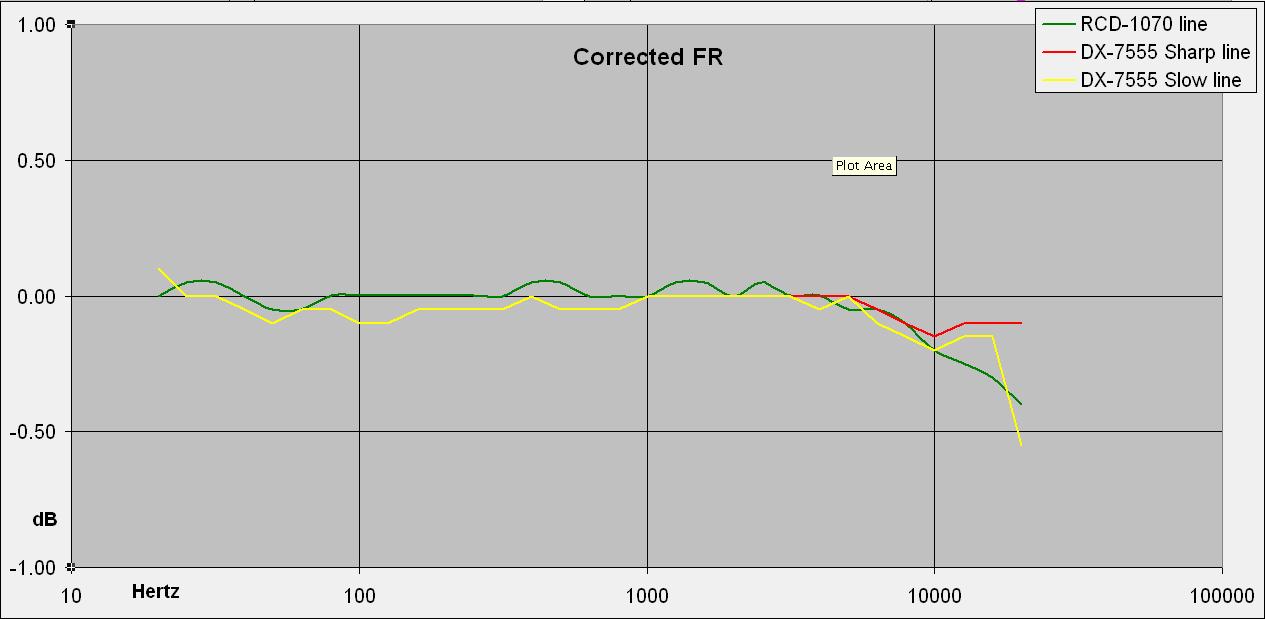
Subjectively, I can tell them apart in a blind test - just barely. But this doesn't necessarily mean they sound different. The Rotel's output is about 0.5 dB higher than the Onkyo. This is likely what I am hearing; I don't know whether I could tell them apart in a level matched comparison.
Build and Parts
The Rotel costs about $700 and the Onkyo costs about $500. As one might expect from this price difference, the Rotel has the edge in build and parts quality.
The Rotel uses higher quality low tolerance parts, a toroidal transforer in its power supply, a clean, solidly made board layout, and Burr Brown OPA2604s driving its analog output stage. The Rotel doesn't have a headphone jack.
The Onkyo uses medium-high quality parts with a standard transformer in its power supply, the board layout is not quite as clean or solidly built, and its analog output stage is driven by Ti 61C814M op amps. The Onkyo has a headphone jack, but it is of low quality (more below).
It is of course debatable whether the Rotel's higher build and parts quality is audible. It may well be - for example the Rotel's 60 Hz power line ripple is 10 dB lower than the Onkyo's (-116 vs. -106 dB). Yet since both are well below -100 dB it's questionable whether this makes any difference. Higher parts quality may mean higher expected reliability and longevity, but of course who knows? Cheap Radio Shack electrolytic caps in one project of mine are running now with 10 years of continual use.
Frequency Response
Frequency response is often the most easily audible aspect of any piece of electronics. I measured it using 1/3 octave warble tones on Stereophile disc #2, played into the analog inputs of my sound board. Then I corrected the response for my sound board's frequency response curve. The results have a margin of error of about 0.1 dB.
The Onkyo has two digital filter modes: sharp and slow.
In slow mode the digital filter is less steep, providing less ripple and phase distortion in the passband.
Here are the FR curves.
Note the scale: they are within 0.1 dB of flat through most of the audible band.

The Rotel and Onkyo are virtually identical from below 20 Hz to 10 kHz, both within less than 0.1 dB of flat. Considering that my margin of error is about 0.1 dB, we can call this perfect ruler flat response. The Onkyo in sharp mode is ruler flat; in slow mode is like the Rotel. Are these differences audible? Perhaps to bats, maybe even a few dogs, but not to most human beings. A difference of 0.1 dB is at or below the threshold of human audibility under ideal test conditions with pure midrange test tones, let alone complex music signals in the top 1/3 octave.
Both have excellent frequency response and it's debatable which of the three is best. Ultimately, they are flat for the entire audible spectrum and -0.5 dB at 20 kHz is an inaudible amount of rolloff. That said, the Rotel has the smoothest, most linear rolloff. This gives the least amount of phase and amplitude ripple in the passband and is probably the least audible. But "audible" is a shaky term comparing two so similar curves. Suffice to say that both are excellent and indistinguishable to 99.9% of humanity including most audiophiles like myself.
Harmonic Distortion
Next I measured their harmonic distortion and noise with a 500 Hz pure tone. Before going further it's important to note that all of my distortion measurements used the analog input of my sound board, so they include the distortion in the sound board itself. Thus it is the differences between the graphs, not the absolute numbers, that are meaningful.
The Onkyo has slightly less distortion (perhaps the result of its newer Wolfson DAC?)
while the Rotel has a slightly cleaner power supply
(perhaps a result of its toroidal transformer?).
For all practical purposes they are identical.
Here is the Rotel:
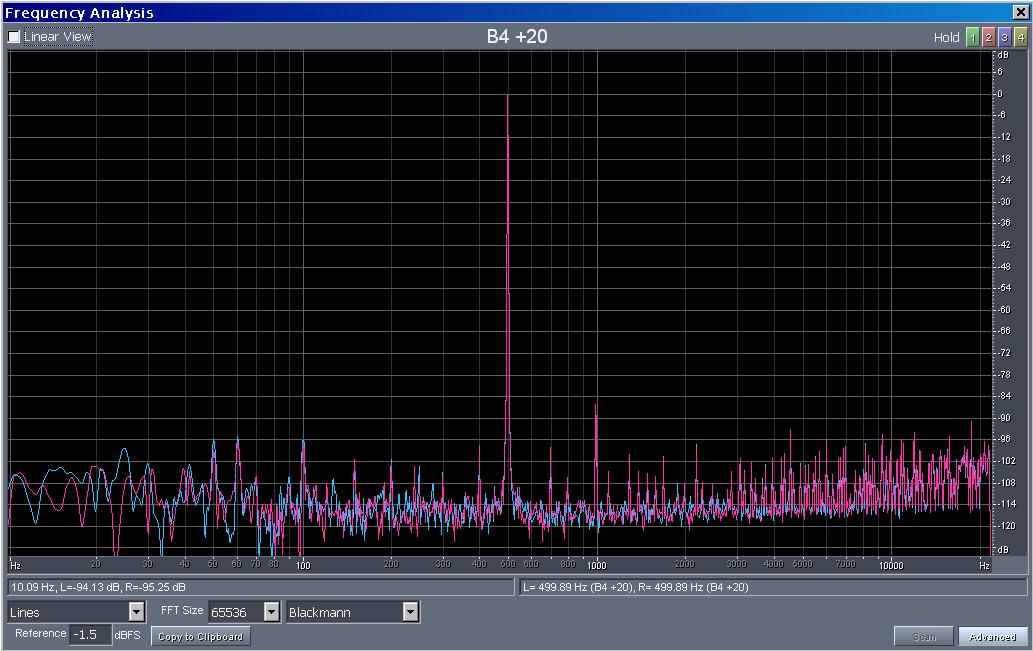
The first harmonic at 1 kHz is 87 dB below the signal (which itself was at -20 dB).
This exactly matches Rotel's factory specification.
All other harmonics are at -90 or lower.
The 60 Hz power line ripple is 96 dB below the signal,
which is -116 dB in absolute terms since the signal was at -20 dB.
Here is the Onkyo:
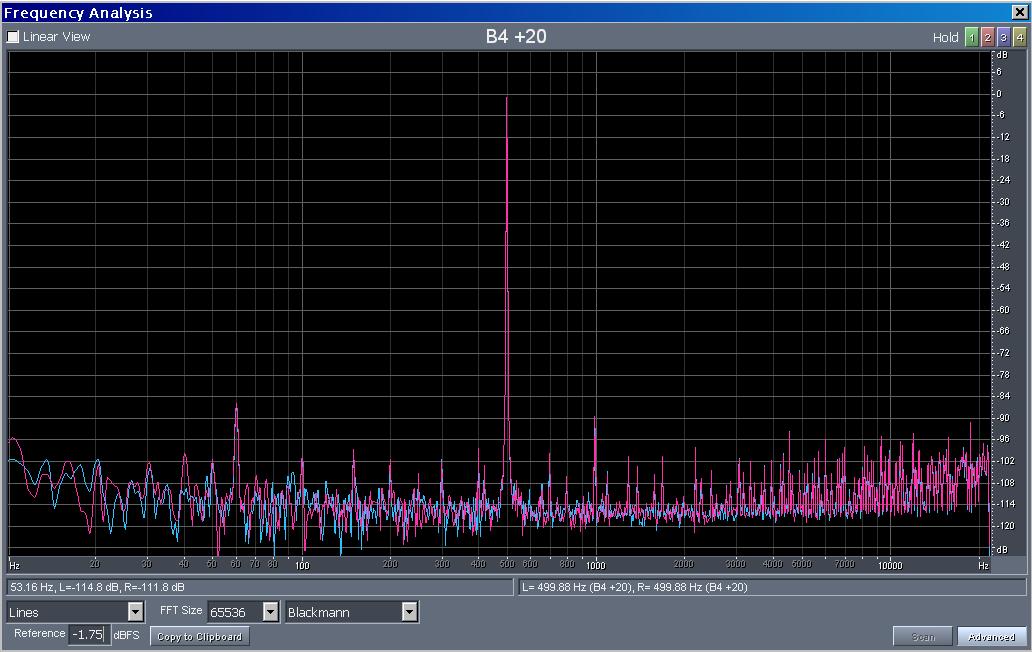
The first harmonic at 1 kHz is 90 dB below the signal.
This is slightly higher than factory spec of 0.0027% which is -91 dB.
All other harmonics are at -90 or lower.
The 60 Hz power line ripple is about 86 dB below the signal,
which is -106 dB in absolute terms since the signal was at -20 dB.
Intermodulation Distortion
Last I measured intermodulation distortion. I meaured this with a worst-case scenario. A signal consisting of both 19 kHz and 20 kHz, at 0 dB (full scale).
Since most DACs go nonlinear at full scale (near digital 0 dB),
I also ran the same test signal at -1 dB to check the difference.
The original waveform consists of 19 kHz and 20 kHz, each at digital -6 dB,
so their sum waveform hits 0 dB (full scale without clipping).
My modified waveform consists of 19 kHz and 20 kHz, each at digital -7 dB,
so their sum waveform hits -1 dB.
You may be surprised at the results.
Here is the Rotel at 0 dB:
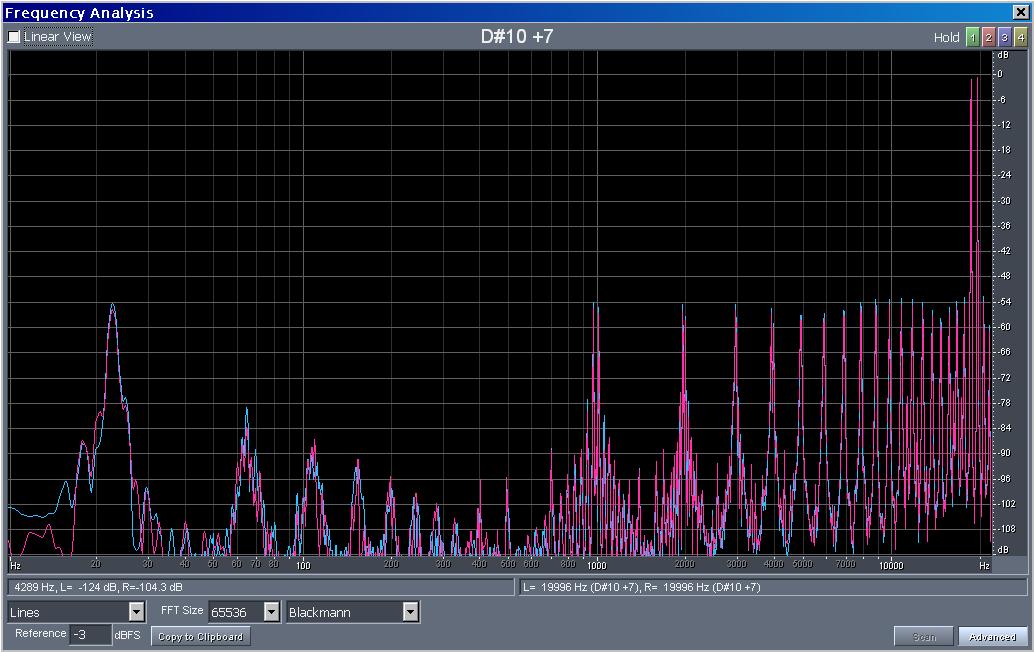
Most of the intermodulation frequencies peak at 54 dB below the signal.
That sounds pretty bad, but this is a worst case test of an extremely difficult signal
designed to highlight whatever IM distortion exists.
Here is the Onkyo at 0 dB (full scale):
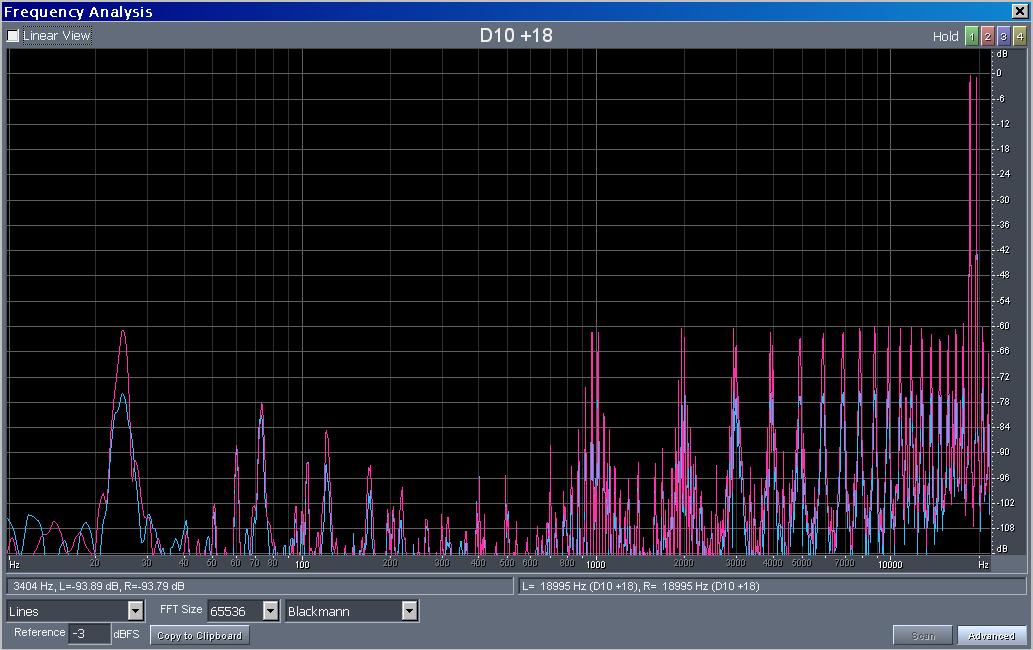
Here is the Onkyo at -1 dB:
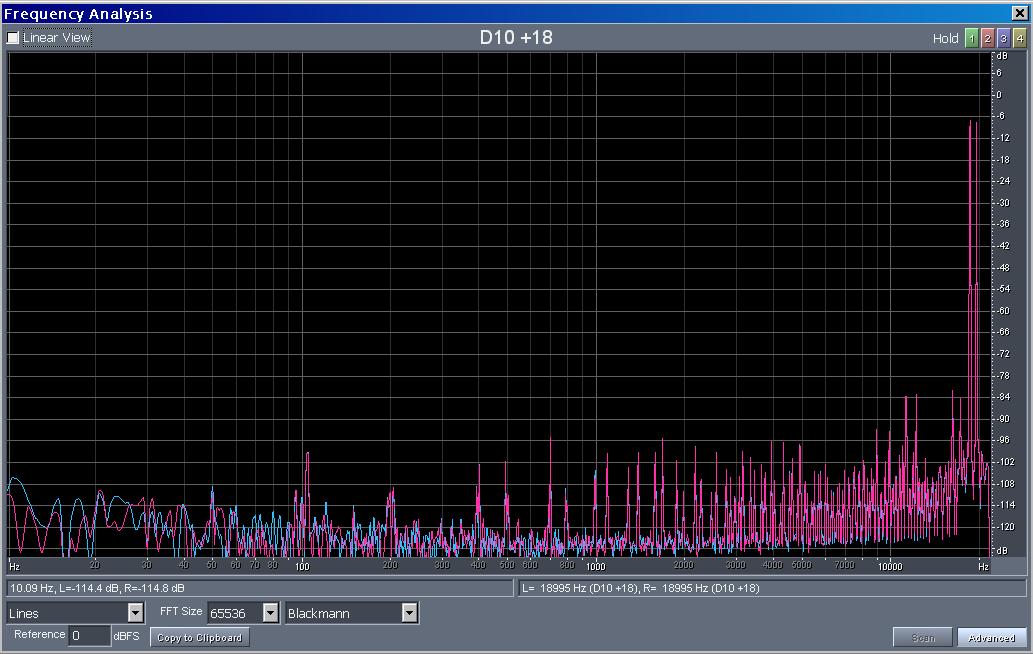
The above two graphs illustrate how DACs go nonlinear near full scale.
At full scale the intermodulation frequencies peak at -60 dB, about 6 dB less than the Rotel.
This is a significant improvement (half the distortion), though it's questionable whether it is audible.
At -1 dB, the distortion drops 30 dB or more.
In other words, a 12% reduction in level gives a 97% reduction in distortion.
IM at -60 dB seems high, but consider:
only test signals use digital 0 dB full scale - music recordings do not.
And, even at -60 dB, the distortion is about 10 times lower than a really good turntable cartridge.
CONCLUSION
These CD players are similar, both subjectively and as measured. There are slight differences in measurements but nothing significant and nothing audible (at least obvious to me). Their linearity and distortion is so low I would need a better sound board to measure them accurately.
Subjectively, every time I think I hear a difference between them it is so subtle and elusive I can't pin it down. But this is what audio mania is all about: splitting hairs. One could say that the Onkyo is a touch smoother or more clear than the Rotel, while the Rotel is touch quieter. But that knowledge comes from measuring test signals. I'm not sure any human being could come up with that in a double blind listening test. The Rotel has a stiffer/stronger output stage, but this doesn't matter in most real world applications, since virtually any preamp or amp will have a 10 kOhm or higher input impedance.
I find it interesting that some audiophiles rave about how great the latest D/A chips are. For example, higher data rates like SACD and DVD-audio, or newer implementations of standard 16/44 CD. I've read the specs on some of the old & new chips and the new ones are better, primarily with lower distortion (as seen in the above). But this seems to me to be a distinction without a difference. Even 5 to 10 years ago the D/A chips were good enough that the limiting factor of CD player sound quality was the power supply and analog output stage. 24 bits may give 144 dB of dynamic range, but the human ear can't perceive that without pain or hearing damage, and due to thermal noise of resistors and other limitations, it's difficult to build any analog stage with a S/N ratio higher than around 120 dB. 96 kHz sampling may give a Nyquist limit of 48 kHz with a smoother slope digital filter virtually eliminating passband ripple. But passband ripple with standard 16/44 CD is already below human audibility.
Higher bit rates do leave more margin for safety or error - the inherently higher resolution pushes the limitations further from audibility. The limitations of 44.1 kHz / 16 bit are generally below human audibility, but in some cases just barely below. Because of this, any mistakes in implementation are likely to become audible. So it takes a high level of engineering to make a redbook CD player sonically transparent. Based on my listening and measurements, both of these CD players definitely reach that mark. I can't say the same for some other CD players.
This is not to say that all CD players sound the same. Some do indeed sound different, but some are designed to sound different. The more interesting question is, "do all well engineered CD players sound the same?" By "well engineered" I mean designed and built to produce the flattest possible frequency response with the lowest possible noise and distortion. The truth is anyone's guess, but my inclination is to say "yes". In other words, I believe the technology does exist to make redbook CD sonically transparent. Clearly, not all CD players reach that mark, but some do, and they don't have to cost a fortune.